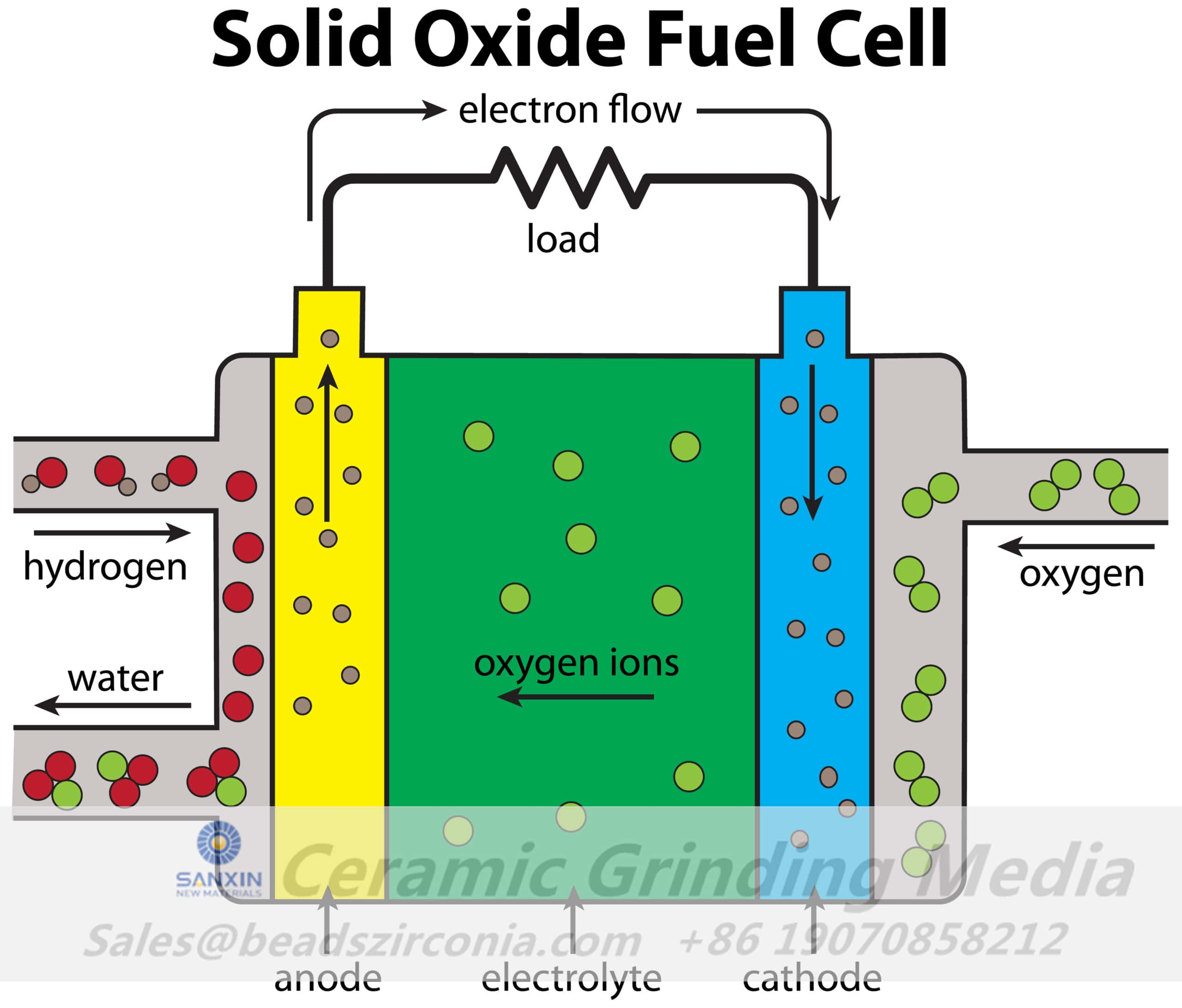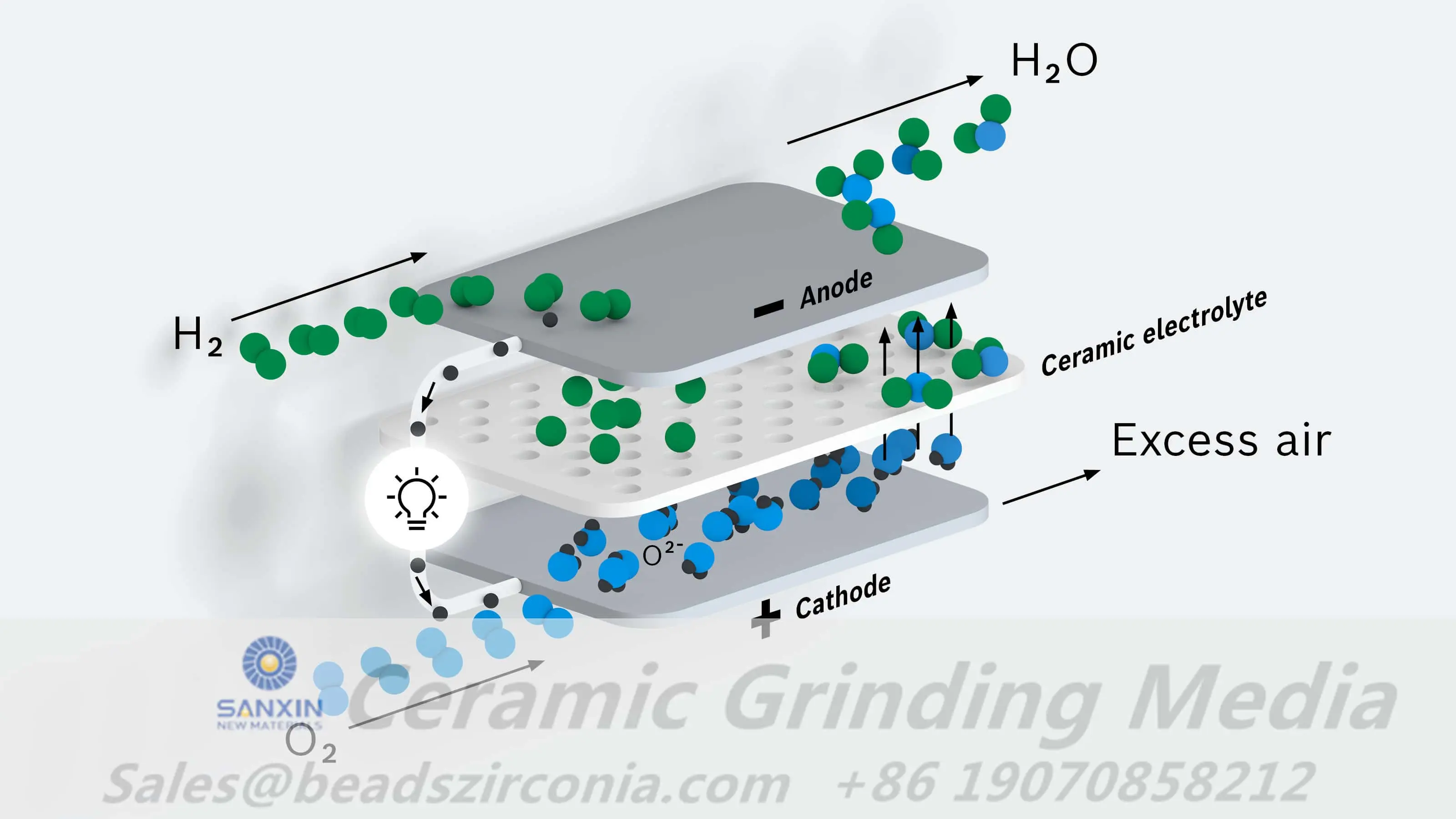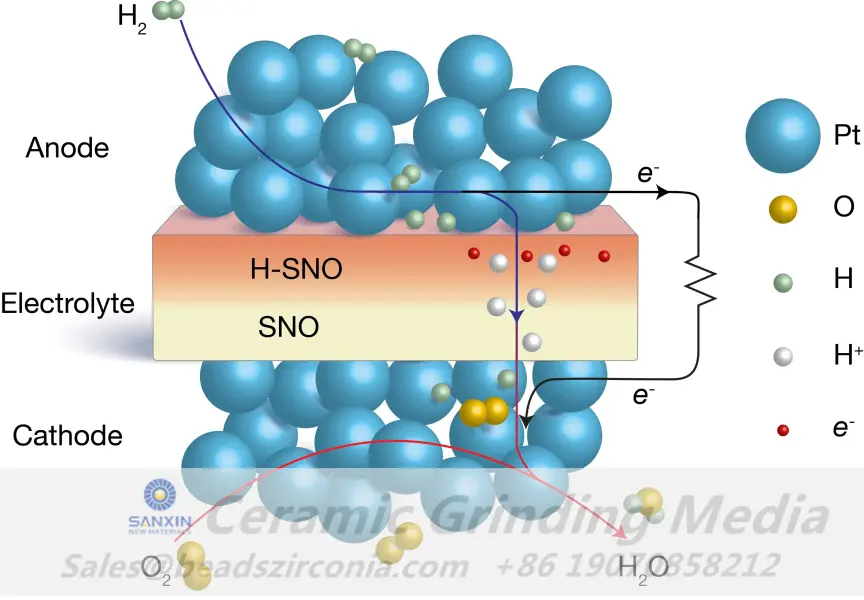
Solid Oxide Fuel Cells (SOFCs) are an advanced type of fuel cell that generates electricity through an electrochemical reaction rather than combustion. Unlike traditional power generation methods, SOFCs achieve higher efficiency while producing lower emissions.
SOFCs differ from other fuel cells in their ability to operate at high temperatures (700°C to 1000°C), which enhances reaction rates and eliminates the need for expensive precious metal catalysts. This makes them a cost-effective alternative for long-term power generation solutions.
Fuel Versatility – SOFCs can operate on multiple fuels, including hydrogen, natural gas, syngas, biogas, and other hydrocarbons, allowing them to adapt to different regional energy infrastructures.
High Efficiency – They can achieve efficiency levels of 50%-60% in standalone mode, and up to 85% in combined heat and power (CHP) applications.
Minimal Environmental Impact – When operating on hydrogen, SOFCs emit only water vapor as a byproduct, making them a clean energy solution. Even when using hydrocarbon-based fuels, they produce significantly lower carbon emissions than traditional combustion-based systems.
Long Operational Lifespan – With fewer moving parts and solid-state construction, SOFCs have an expected lifespan of over 40,000 hours, making them more durable than other fuel cells.
Scalability – SOFCs are suitable for applications ranging from small-scale residential power units to large industrial power plants.
SOFCs use a solid ceramic electrolyte to facilitate the movement of oxygen ions (O²⁻) from the cathode to the anode. The basic working mechanism is as follows:
Oxygen molecules from the air enter the cathode and are reduced to oxygen ions (O²⁻).
These oxygen ions travel through the solid oxide electrolyte toward the anode.
At the anode, fuel (hydrogen or hydrocarbons) reacts with the oxygen ions, producing electricity, heat, and water.
Electrons flow through an external circuit, generating usable electric power.
This process is fundamentally the reverse of water electrolysis, making SOFCs suitable for both power generation and hydrogen production (when operated in reverse as SOECs).
Each SOFC is composed of a single fuel cell unit (also known as a single cell), which includes key components that determine its efficiency, durability, and performance. These components are designed to facilitate efficient fuel oxidation while maintaining high operational stability.
The anode is responsible for oxidizing the fuel by reacting it with oxygen ions.
It must possess high electronic and ionic conductivity to allow smooth electron transfer.
The anode should resist carbon buildup and sulfur poisoning, especially when using hydrocarbon fuels.
Common anode materials:
Nickel/Yttria-Stabilized Zirconia (Ni/YSZ): The most widely used anode material.
Perovskite-based materials (La₀.₇Sr₀.₃CrO₃): More resistant to sulfur and carbon deposition.
The cathode enables oxygen molecules to gain electrons and form oxygen ions.
It must have high oxygen surface exchange activity for rapid reaction kinetics.
Common cathode materials:
Lanthanum Strontium Cobalt Ferrite (LSCF) – Known for high oxygen exchange rates.
Perovskite-based cathodes – Offer enhanced electrochemical performance.
The electrolyte’s primary role is to transport oxygen ions from the cathode to the anode while preventing electron leakage.
It must be chemically stable at high temperatures and have low electrical conductivity to ensure efficient ion flow.
Common electrolyte materials:
Yttria-Stabilized Zirconia (YSZ): The most used electrolyte, operating efficiently above 800°C.
Gadolinium-Doped Ceria (GDC): A promising material for lower-temperature SOFCs (600°C–800°C).
Interconnects connect multiple SOFC cells to form a stack, which increases power output.
Sealants ensure gas-tight operation and prevent performance degradation.
Different SOFC designs offer various advantages depending on application needs.
Features a cylindrical, tube-like structure.
Advantages:
Higher mechanical stability.
Easier gas sealing.
Long operational life.
Disadvantages:
Expensive to manufacture.
Lower power density than planar SOFCs.
Uses flat ceramic plates stacked together to maximize power density.
Advantages:
High efficiency and power output.
Easier scalability for industrial applications.
Disadvantages:
Difficult to maintain gas-tight sealing.
Prone to thermal cycling issues.
A hybrid of tubular and planar SOFCs.
Advantages:
Enhanced mechanical durability.
Moderate power density.
Disadvantages:
More complex manufacturing process.

SOFCs are revolutionizing energy sectors by providing high-efficiency, low-emission power generation solutions across different industries.
SOFCs are increasingly used for on-site power generation due to their high efficiency and low emissions.
Key Benefits:
Eliminates energy transmission losses.
Reduces dependency on centralized power grids.
Enables combined heat and power (CHP) applications.
Real-World Examples:
Bloom Energy Servers – Used by Google, Apple, and eBay for data center backup power.
Chaozhou Sanhuan 100 kW SOFC Project – Demonstrating commercial viability in China.
SOFC technology is being integrated into electric vehicles (EVs) and maritime applications to reduce carbon emissions.
SOFC-Powered Vehicles:
Ethanol-based SOFC cars developed in Japan with 600km driving range.
SOFC for Maritime Applications:
Samsung Heavy Industries is incorporating SOFCs into ship propulsion systems for low-emission maritime transport.
Coal Gasification + SOFC (IGFC) Systems are being explored to improve efficiency while capturing CO₂ emissions.
Mitsubishi Hitachi 1MW SOFC System – A large-scale SOFC project demonstrating high energy efficiency.
SOEC technology allows water electrolysis to produce hydrogen efficiently at an 85%-95% conversion rate.
Used for renewable energy storage to balance supply-demand fluctuations.
Despite its many advantages, SOFC technology faces several hurdles that must be overcome to achieve widespread adoption.
High-temperature operation complicates material selection and long-term durability.
Thermal cycling issues can cause material degradation over time.
Sealing high-temperature SOFCs remains a major challenge.
Developing low-cost, high-performance materials.
Scaling up production to drive down costs.
Optimizing manufacturing techniques to improve efficiency.
As energy demands shift towards cleaner and more efficient technologies, SOFCs are gaining significant traction in various industries. Leading energy companies and startups are investing in research and commercialization to make SOFC technology more viable for large-scale applications.
Several companies across the globe are working on SOFC advancements:
Bloom Energy (USA)
Specializes in commercial and industrial SOFC-based distributed power generation.
Has deployed over 350 MW of SOFC capacity for companies like Google, Apple, and Walmart.
Mitsubishi Heavy Industries (Japan)
Focuses on SOFC-integrated IGFC (Integrated Gasification Fuel Cell) power plants.
Successfully developed a 1 MW SOFC system for large-scale applications.
Bosch (Germany)
Develops 10 kW SOFC combined heat and power (CHP) systems for small businesses.
Invested heavily in Ceres Power, a UK-based SOFC technology company.
Kyocera (Japan)
Specializes in residential SOFCs (700W units) with a lifespan of over 12 years.
Weichai Power (China)
Developed a 120 kW metal-supported SOFC system with a record efficiency of 92.55% in CHP mode.
These companies are driving innovation by improving SOFC durability, efficiency, and scalability, making the technology more accessible for broader applications.
Several countries are supporting SOFC research and commercialization through policies and subsidies:
United States: The Department of Energy (DOE) funds SOFC research under the Solid State Energy Conversion Alliance (SECA) program.
Japan: The ENE-FARM initiative promotes residential SOFCs for household energy efficiency.
Germany: Provides incentives for SOFC-based CHP systems to improve industrial energy efficiency.
China: The government has identified SOFCs as a key technology under its hydrogen and fuel cell development plan.
Despite recent advancements, SOFC commercialization still faces challenges related to high manufacturing costs and material degradation over time. Researchers and engineers are focusing on:
Developing new, cost-effective materials to replace expensive ceramics.
Improving SOFC stack designs to enhance power density and durability.
Scaling up production to lower costs through economies of scale.

SOECs are an extension of SOFC technology, operating in reverse mode to produce hydrogen from water using renewable electricity. This approach is key to solving renewable energy intermittency issues.
How SOEC Works:
Uses high temperatures (700°C–900°C) to split water molecules into hydrogen (H₂) and oxygen (O₂).
Achieves higher efficiency (85%-95%) compared to traditional alkaline or PEM electrolysis (70%).
Applications of SOEC Hydrogen:
Hydrogen can be stored and converted back into electricity when needed.
Used as feedstock for ammonia or methanol production in the chemical industry.
Can replace fossil fuels in steel manufacturing and other energy-intensive industries.
SOEC Adoption Trends:
Europe is investing heavily in hydrogen infrastructure, with Germany leading the Hydrogen Valley initiative.
China is exploring SOEC-powered hydrogen refueling stations for fuel cell vehicles.
Japan is integrating SOEC with its hydrogen economy strategy, supporting renewable energy storage.
Despite its vast potential, SOFC technology still faces significant technical and commercial challenges that must be addressed to achieve widespread adoption.
SOFCs operate between 700°C and 1000°C, requiring heat-resistant materials that do not degrade over time.
Thermal cycling causes mechanical stress, leading to material failure in repeated heating-cooling cycles.
Potential Solutions:
Developing intermediate-temperature SOFCs (IT-SOFCs) that operate at 500°C–700°C using cerium-based electrolytes.
Enhancing catalyst stability to prevent electrode degradation.
SOFC systems require high-purity ceramic materials, increasing production costs.
Stack manufacturing remains complex, limiting mass production scalability.
Cost Reduction Strategies:
Research into cheaper, high-performance electrode materials such as perovskites.
Using metal-supported SOFCs instead of ceramic-supported ones.
Optimizing automated production to reduce labor costs.
Unlike PEM fuel cells, SOFCs take several minutes to hours to reach operating temperature.
They are not ideal for rapid load changes, limiting their use in mobile applications.
Potential Improvements:
Developing hybrid SOFC systems with lithium-ion batteries for peak load balancing.
Advancing micro-SOFC designs for faster startup times.
SOFC lifespans range from 20,000 to 40,000 hours, but degradation over time affects performance.
Sulfur poisoning and carbon buildup impact electrode efficiency.
Enhancements:
Introducing protective coatings to extend cell lifespan.
Developing self-cleaning anodes to resist sulfur and carbon accumulation.
Nano-engineered catalysts can improve reaction rates while lowering costs.
Metal-supported SOFCs (MS-SOFCs) offer better mechanical stability and thermal cycling resistance.
Hybrid SOFC-PEM systems could allow for more flexible power output.
Aerospace: NASA is exploring SOFCs for long-duration space missions and lunar bases.
Military Applications: SOFCs provide silent, portable power for military bases.
Rural Electrification: SOFC-powered microgrids can bring power to off-grid locations.
AI-based predictive maintenance can improve SOFC efficiency by analyzing real-time performance data.
IoT sensors can optimize fuel distribution and heat recovery for maximum efficiency.
Solid Oxide Fuel Cells (SOFCs) are emerging as a key technology in the global energy transition, offering high efficiency, fuel flexibility, and sustainability. Their applications range from distributed power generation and industrial energy systems to hydrogen production and transportation.
However, technical barriers such as high operating temperatures, material costs, and startup times still hinder widespread adoption. Innovations in materials, hybrid systems, and automation will be crucial in bringing SOFCs into mainstream energy markets.
As governments and corporations accelerate investments in hydrogen and fuel cell technology, SOFCs will likely play a pivotal role in achieving a carbon-neutral future.
SOFCs have higher efficiency (50%-60%) and can use multiple fuels, including hydrogen, natural gas, and biogas, unlike PEM fuel cells, which require pure hydrogen.
Key challenges include high operating temperatures, slow startup times, and expensive materials. Research is ongoing to address these issues.
Yes, SOFCs can use natural gas and syngas, but hydrogen is preferred for reducing carbon emissions.
Most SOFCs last between 20,000 and 40,000 hours, with some advanced designs exceeding 60,000 hours.
Major industries investing in SOFCs include data centers, industrial manufacturing, shipping, aviation, and hydrogen production.
For more advices and knowledge about Ceramic Grinding Balls, Sand Millls, please contact with our sales:
Charls Shaw
Sales Manager |Sanxin New Materials
Mobile:+86 19070858212(WhatsApp)
Email:sales@beadszirconia.com
Website:https://www.beadszirconia.com
Anyuan Industrial Park, Pingxiang City, Jiangxi Province, China

Submit your demand,
we will contact you ASAP.

Sanxin New Materials Co., Ltd. focus on producing and selling ceramic beads and parts such as grinding media, blasting beads, bearing ball, structure part, ceramic wear-resistant liners, Nanoparticles Nano Powder

